Shark Bay Cruising Notes
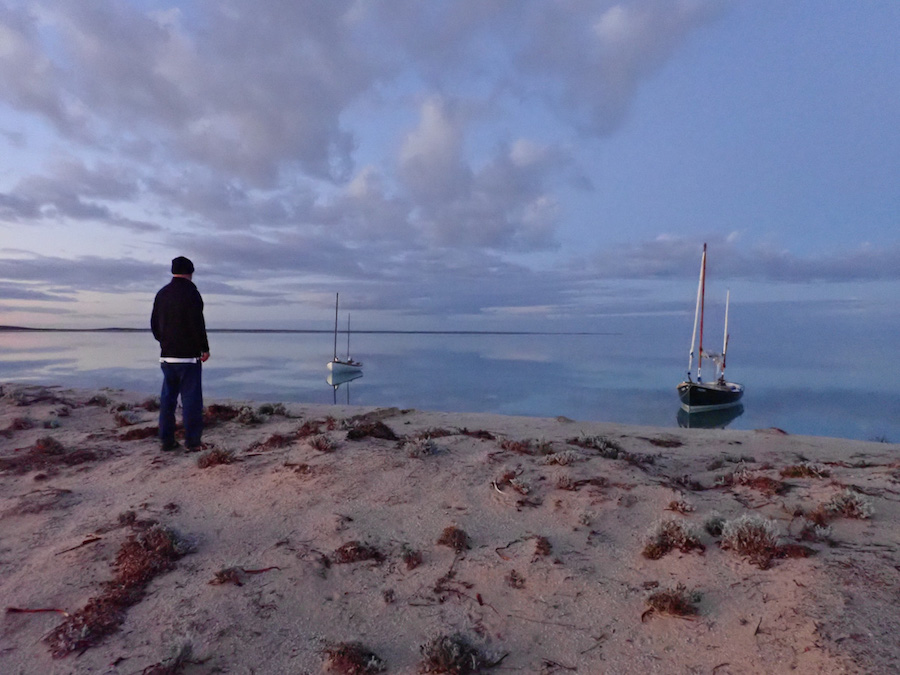
Here are some notes on the practicalities of sailing unsupported in such a remote location. I hope this will encourage you to take the plunge and try a Shark Bay adventure too.
The first thing to do is get a copy of A Small Boat Cruising Guide to Shark Bay by Terry Hinchliffe and Leon Deschamps. It is available in paper or ebook from Hinchy Books, PO Box 21. Dowerin, WA 6461. www.publications.hinchy.org
I wish I had encountered this book earlier. It is an invaluable guide to Shark Bay written from the perspective of a small trailer sailer and is very relevant to our style of sailing.
Boat
Needless to say your boat must be rugged, sea worthy, and simple to sail. It will cop some abuse and probably receive some minor damage too, you cannot be too precious about it. Reefing systems need to be quick and simple to use. Everything must work reliably. For maximum convenience the hull shape should be such that it stays upright when aground. You will have your boat sitting high and dry on the low tides routinely.
Good upwind performance is important. There will be times when you have to cover considerable distances upwind, perhaps as much as 20km in a day.
Your boat will inevitably be filled with gear and the cockpit will get cluttered. A useful thing to do is to make boards that cover the forward part of your cockpit. Your gear can then sit under these boards. This will allow you to walk forward unimpeded and safely across your gear (and without damaging your gear) as you work your boat. You may also want the boards to sleep on.
Outboard
You should have one. As well as strong winds one can encounter extensive periods of no wind. Having an outboard gives you a better chance of getting to your next destination before dark. I would not like to repeat the midnight arrival in Tetradon Loop that Paul Ricketts and I made in 2015! gaffers.org/index.php/trip-and-event-blogs/shark-bay-day-2/
Clothing
You need good wet weather sailing gear. A good set of pants and jacket. Strong winds with constant spray can make you very cold. In October 2016 I was routinely wearing an additional light weight spray jacket under my main sailing jacket in order to keep warm on the windy days.
Night times can also get surprisingly cold. At times in June 2017 Chris and I were wearing three layers of clothing inside our sleeping bags.
You are in the sun all day. The sun is potentially more dangerous than all the sharks in Shark Bay. On warm sunny days it is useful to wear light weight long trousers to protect your legs from the sun. Otherwise I made sure I had a towel to drape over my legs while sailing for protection. Pay attention to the tops of your feet with lots of sun cream and/or footwear such as wetsuit booties or Crocs.
Feet and hands, but mainly feet
After a couple of days into your trip your feet and hands will be tender and sore. Walking will be painful and even the act of opening a plastic container with your hands will hurt. How does this happen? It comes about from your hands and feet being constantly damp and sandy.
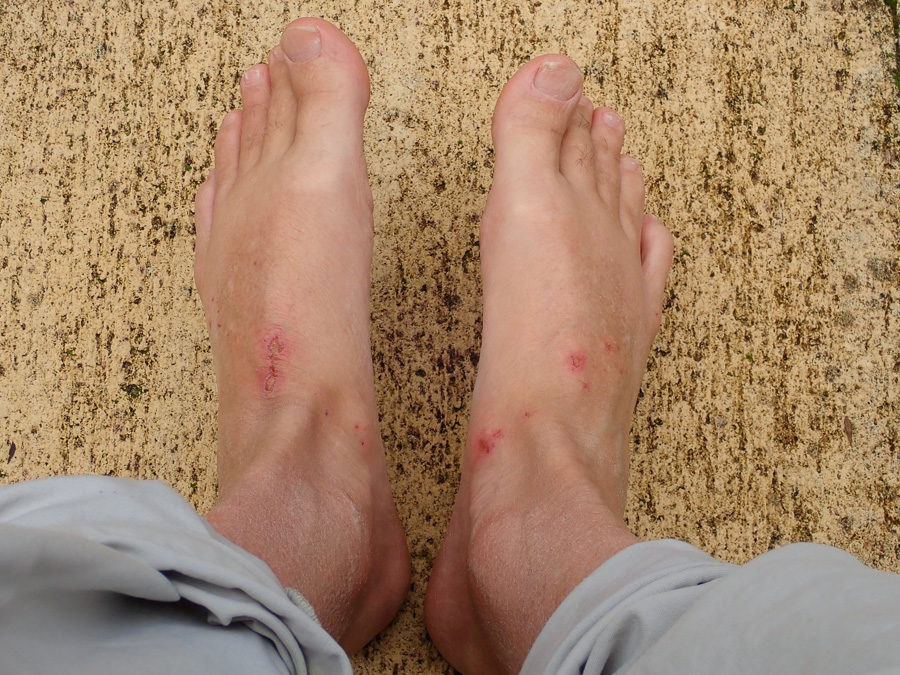
Your feet suffer greatly because they have to be in shoes or sandals. You have to wear something on your feet in the water because our potential exposure to stone fish and other dangerous stinging creatures is high. We are always wading in and out of shallow water and the combination of damp soft skin being abraded by the sand that is inevitably in your footwear quickly produces very painful sores. I am not sure what the best answer is but next time I will try some wetsuit boots for walking in the water. I will have to be careful to ensure there is no sand in them when I put them on and hopefully they will keep the sand out.
Wear gloves to protect the hands from wear and the sun. When the skin becomes soft and pulpy from being damp for a few days it is so easy to cut and graze them. You will handle your anchor rope several times each day. Invest in some nice anchor rope that will be easy on your hands. Get rid of the nasty cheap silver rope that you currently have. Your hands will thank you for this.
Tides
Tide tables should be constantly at your side. Beware when you come ashore anytime after the high tide. In just ten minutes or so while you deal with something on your boat, have a discussion about alternate stopping points, or scout for a camping spot your boat can be left stranded on the sand only to be released in several hours time. Trust us!
The tidal flows in Shark Bay can be significant. The flow through the channels as the large basins fill or empty can be a wonderful boost or a curse. Note also there can be significant differences in the timing of the tides relative to the official tables for Denham. For example we noted that the tides at Petit Point were at least two hours later than indicated by the tables.
The timing of high and low tides can be awkward. There were times when we had to wait until late morning for our boats to float free. Either we had not allowed enough depth before anchoring our boats for the night, or the shallows were too extensive to allow us to do so. In an ideal world you would time your cruising week to coincide with a period when the high tide was in the morning.
Anchor(s)
You will hear the old salts say "You need a good heavy anchor with lots of chain" and you say "Yeah yeah". Well, it turns out that you do need a good heavy anchor with lots of chain!
Your anchoring ground may be a thin layer of easily shifted sand over rock, a low density porridge of sand mixed with shells, or sand mixed with chunks of broken coral that prevent the points of your anchor from burying properly. There are not many bays with good shelter in Shark Bay and your boat can often end up being more exposed that you would like. Whimbrel dragged her anchor on her trip in October 2016 and Gryphon dragged hers on our trip in June 2017. I have spent some nights waking every hour just to check that my boat was still there. I have now invested in a 3.6kg Mantus anchor. It is a bit bulky but its setting and holding power is very impressive and this improves my sleep greatly!
If you have the space a second full sized anchor is probably nice to have. However at least carry a good small anchor. This is handy for either holding the stern away from the beach if the surge is pushing your boat in, or for holding the stern close to the beach when you are loading or unloading when the wind is pushing it off. Warning: Do not get one of those blue plastic Cooper anchors. I had one, they are completely useless. I now have a Mantus dinghy anchor, it is very expensive but extraordinarily good.
Weather
Needless to say you will be always watching the weather. However there are many areas where you can be out of phone reception and will not be able to pick up a forecast over the web. In future I will also take a good old fashioned AM/FM radio for picking up forecasts.
When you do get a forecast take note of what the wind will be at night as well as what it will be during the day. At night your boat will be at anchor and unattended while you sleep. If you know what the weather will be, and have selected your anchorage and prepared your boat accordingly, then you will be able to stay asleep.
Shelter
Exposure from the sun and wind is possibly the most dangerous thing you will encounter in Shark Bay. Over the years I have used a simple tarp shelter that has served me very well. It consists of a 2.4 x 3m (8'x10') tarp, 4 aluminium extendable poles (only 2 need be extendable), and a set of lines with home made PVC sand pegs.
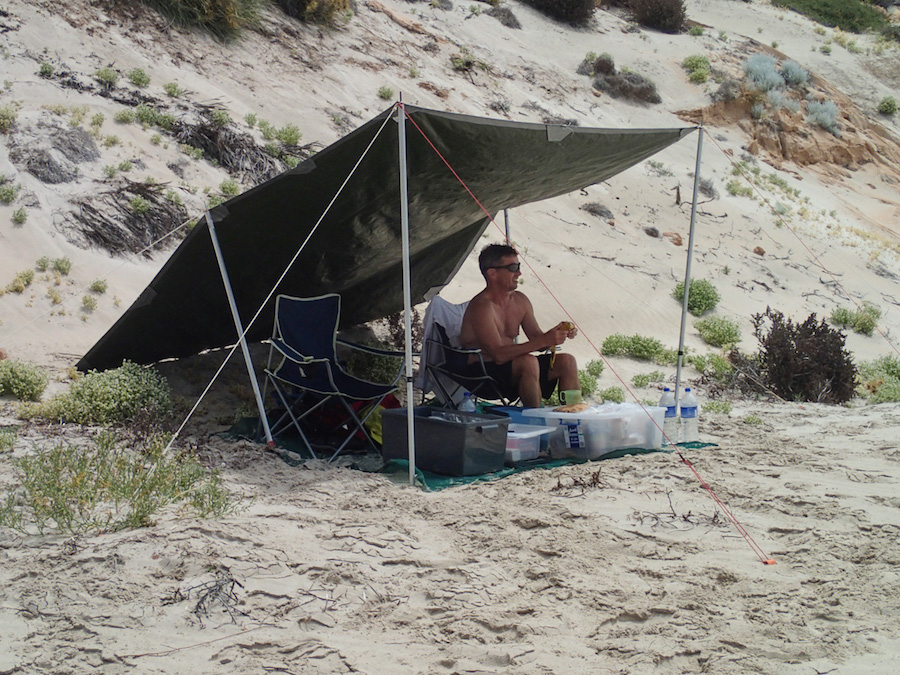
Peg one edge down to the ground on the upwind side using some large sand pegs and use the 4 poles with lines and pegs to form the back wall and roof. This gives you a nice living area protected from sun and wind where you can cook and generally hang around. A piece of 30% shade cloth works wonders as a ground sheet. The shade cloth 'floats' on the sand. Any sand on top (mostly) works its way through the shade cloth giving you a remarkably sand-reduced surface. Don't forget your chair.
Food
Not much to remark about here except that giving yourself a good lunch can be hard. Typically you are on the go sailing and you are not in a good situation to feed yourself properly, especially if you are single handed. I have found that a couple of hard boiled eggs prepared at breakfast time provide you with some nourishing protein pills that you can take on the go. Eggs keep well at the bottom of a cool buoyancy tank. Each day try to prepare a snack box that contains all you need to get you through the middle of the day. Finally, every expedition should include a good fruit cake in its provisioning list!
Spot Tracker
A Spot Tracker or equivalent device is great. The folks back home can follow your adventure vicariously and get considerable enjoyment from this. The sea rescue people will love you too (as long as you tell them your tracker address). They too can follow you with ease without the need for any radio contact. If the worst happens they do not need to search for you, they know exactly where to go.
Navigation
As well as looking at charts study your potential route carefully on Google Earth. Charts are constructed for people with big boats who don't want to go aground. Typically we want to go aground at least twice each day!
What the shallows and beaches are like of of great importance to us. Charts are not much good for this but Google Earth imagery is. The imagery can reveal many small features that cannot be represented on charts but nevertheless can be exploited by a small dinghy cruiser. Print out screen shots of areas of interest to refer to as you sail.
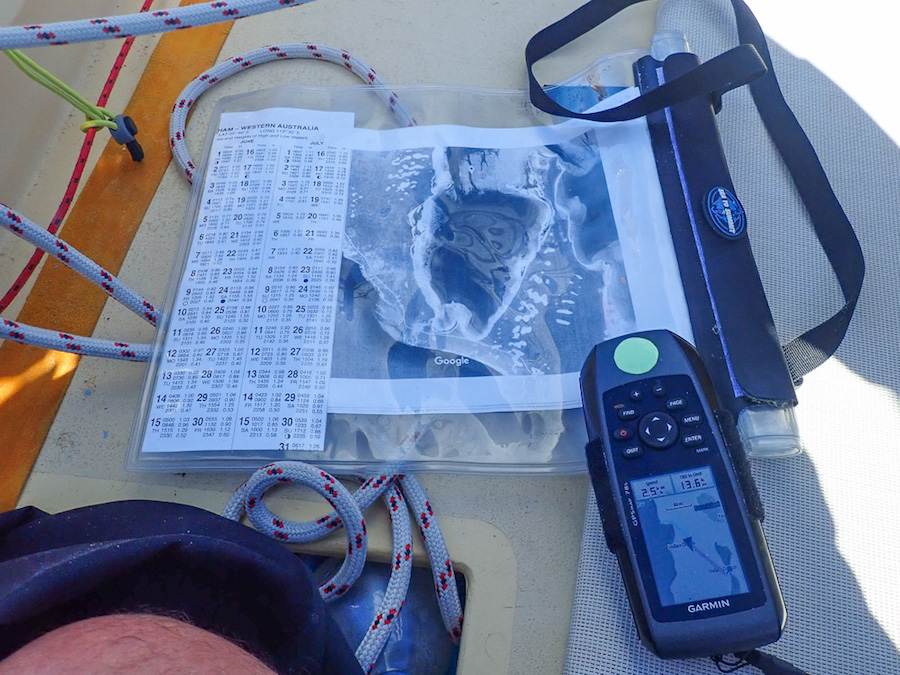
Generally what you are looking for are sheltered beaches where the shallows do not extend too far out from the shore. If your destination has a large expanse of shallows around it you can end up with your boat stranded a fair way from the beach leaving you with a long walk to get gear on and off your boat.
You should carry a GPS. Visual navigation can be hard, so many headlands and bays look alike. Using your hand held GPS drive the cursor to your destination and create a waypoint. Once you have a heading you can steer to your compass. A basic compass is all you need. You cannot steer a dinghy to better than 5 or 10 degrees at most, so there is no point in anything fancy. I use a Garmin kayaking compass held with shock cord to the top of my centre case.
Camp ashore or sleep aboard?
Ideally make arrangements for both options. The shore may be such that you are forced to sleep aboard, or your anchoarge may be so uncomfortable that you are forced to sleep ashore. Of course it depends on your boat but generally camping ashore is very much more comfortable than sleeping aboard. However, the cost is the effort of moving all your gear on and off the boat each day. Needless to say you should try to organise things so that the amount of gear you have to move is minimised.
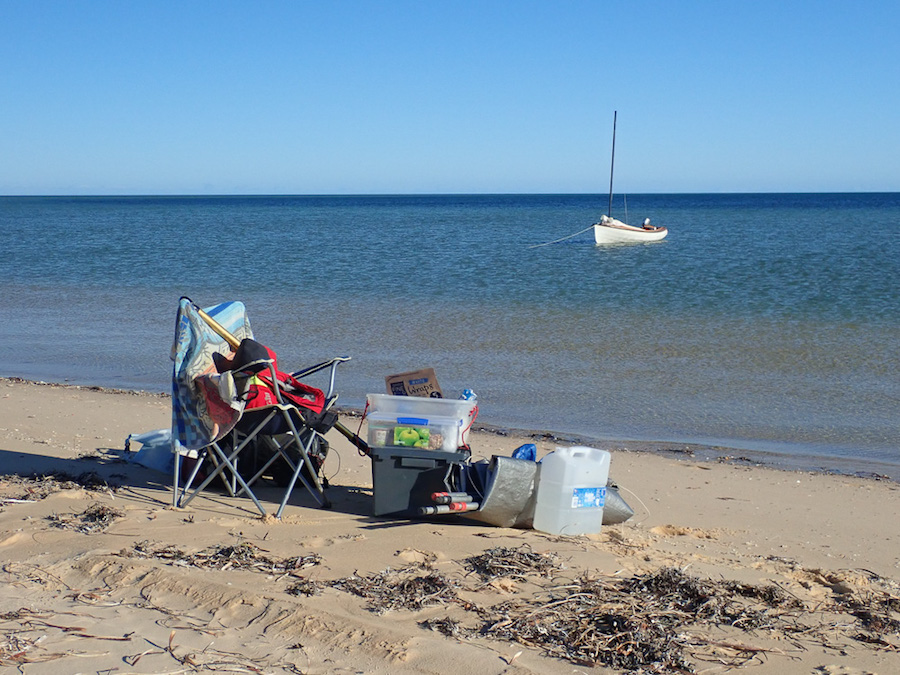
Power and Charging
With just a little work keeping your gear charged is not too hard. The system I have put together with bits from Whitworths consists of a 12V 7.5AH battery with a cigarette lighter socket, a 10W Sunyo panel, and a 4 Amp Phocos charge controller.I attached the charge controller to the top of the case that came with the battery to minimise the number of separate things. I am not sure how important it is to have a charge controller for a such a small panel but it seemed wise and did not cost too much.
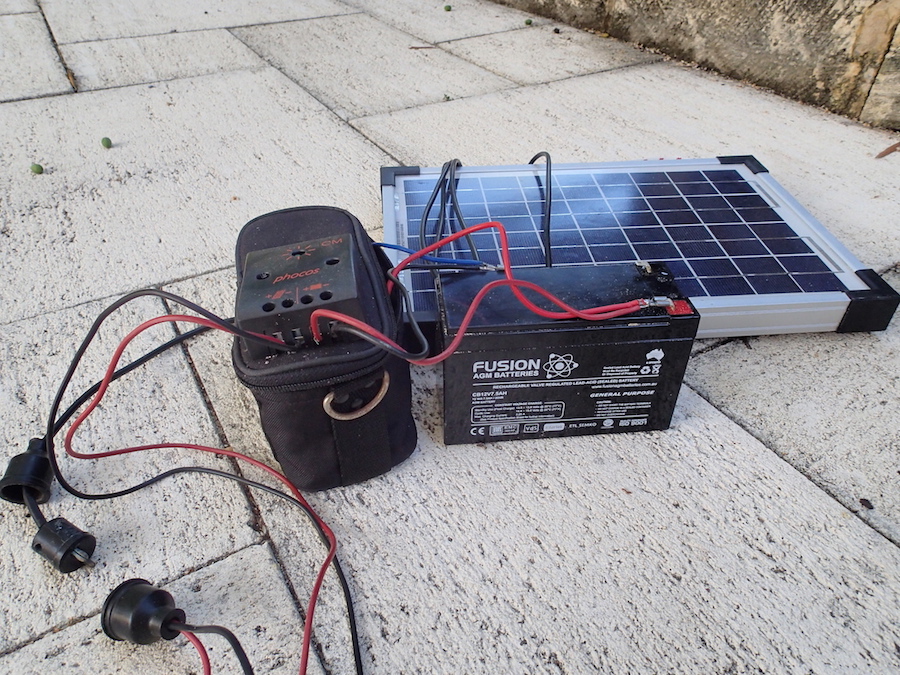
I used a (not very good) connector between the panel and the charge controller. The connector is useful because I can take the battery off the boat at the end of the day and recharge all my bits and pieces on shore.
I have no fixed mounting spot for the solar panel. It sits loose in the cockpit and I slide it around as needed to keep it out of the shade of the sails and in the sun. Being loose I can also bring the panel ashore with the battery so that I can keep charging it.
With a bit of looking around you can source AA battery chargers that work from a 12V cigarette lighter, I got mine from Jaycar. I also managed to find a cigarette lighter charger for the battery of my SLR camera online.
When you store the system make sure you disconnect the battery from the charge controller as there is a very small residual circuit that will eventually flatten the battery (how do I know that?)
Finally
Do not get intimidated. The preparations and precautions one should take are straightforward. The hardest part is making the decision to go. Just do it! Anyone can do it, you will cope just fine. Make sure that you have a relaxed timetable so that you can sit out the days that are not good for sailing. Don't be too dogmatic about your planned destinations, choose and change them to suit the wind directions. It really does not matter where you go in Shark Bay, everywhere is amazing.